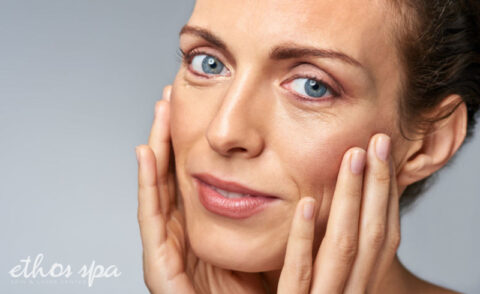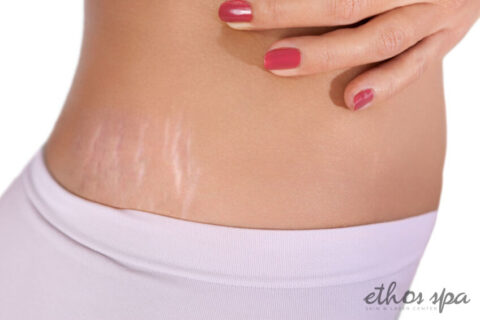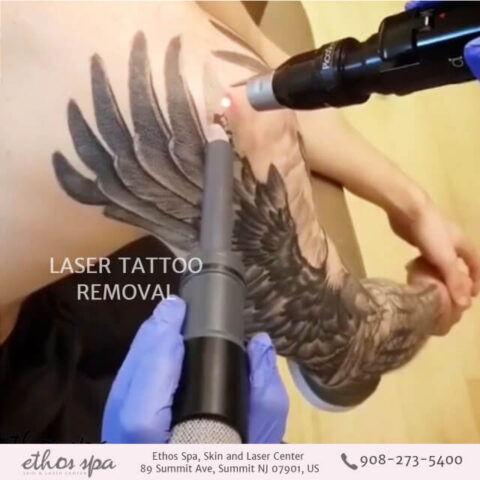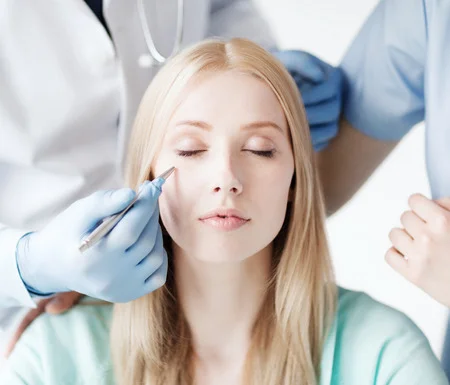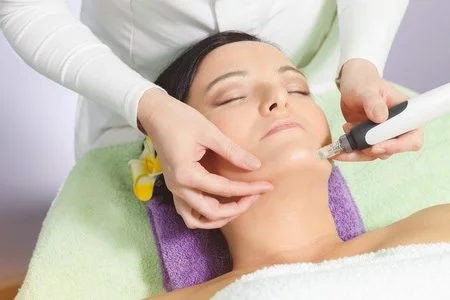Microneedling is a procedure that punctures microscopic holes into the skin to provoke the body’s natural healing mechanism. Once the body begins to heal the punctures, new collagen is produced – rejuvenating the skin’s quality and repairing damages like acne scars. While microneedling is an effective and minimally invasive cosmetic procedure, it can still cause side effects like redness after treatment.
So how can you reduce the redness in your skin after microneedling? Pre-treatment measures such as taking acetaminophen and adjusting needle-length and speed can prevent extreme pinkish, sensitive skin. Proper aftercare by avoiding excessive sun exposure, alcohol, exercise, and exfoliation will also help curb discomfort after the treatment.
What To Expect With Microneedling: Before and After
Microneedling is a minimally invasive cosmetic procedure that uses a device covered in tiny, fine needles to create ‘micro-injuries’ that prompt the skin to stimulate its collagen production. Also known as collagen induction therapy, microneedling therapy can promote smoother, softer skin and address concerns such as:
- Acne scars
- Stretch marks
- Sagging
- Sun spots
- Deep wrinkles or fine lines
- Skin pigmentation issues
- Poor skin complexion and texture
Many board certified cosmetic surgeons create a specialized treatment plan for their patients by staggering 4 – 5 microneedling sessions over a period of two to four weeks. An ideal candidate for microneedling is someone who is in good health and has certain skin issues that haven’t responded to other dermatologic procedures.
However, microneedling may cause certain side effects that require some downtime. Common side effects experienced by patients in the days following a microneedling treatment include:
- Redness
- Skin irritation or sensitivity
- Bleeding
- Bruising
- Peeling
- Infection
To prevent skin irritation when micro needling (before and after), here are some things you should prepare for ahead of time:
| Before Treatment | Avoid acne medication Accutane six months prior to your treatment.Unprotected sun exposure, IPL or laser procedures should be avoided 2 weeks prior to the procedure.Do not use topical against such as retinoids or exfoliants for at least one week before your treatment. These will cause extra sensitivity. No waxing, depilatory creams, or electrolysis in the treatment area 5-7 days prior. If there is dense hair in the treatment area, shave the day before your appointment. Avoid any anti-inflammatory medications such as Motrin, Advil, or Ibuprofen for at least 3 days prior. |
| Day of Treatment | Expect your in-office microneedling session to take up to 60 minutes to complete. It’s best to arrive 30 – 45 minutes earlier than your schedule, so your doctor can prepare your skin by applying topical lidocaine. Inform your skin specialist about any relevant changes in your medical history or the medications you are taking.Keep your skin clear of lotion, powder, makeup, oil, or sunscreen. |
| After Treatment | Expect a sunburn-like effect for the first three days. Your skin will feel tight, dry, or sensitive to touch. Be gentle with your skin and use only your hands to pat it dry, no earlier than 4 hours after treatment. Some redness, bruising, or swelling may occur in the first 48 hours after microneedling. Peeling, dryness, and flaking may increase after 3-5 days due to an increased turnover of skin cells. Avoid picking, scratching, or scrubbing treated skin. Let it flake off naturally and keep it moisturized at all times.Around a week after your session, you may use your regular skin care products again. For best results, follow-up and repeat treatments every 4-6 weeks are recommended. |
It’s always best to discuss with your doctor on how to prepare before the procedure to have the best possible outcome. Be sure to ask questions during your consultation so you can undergo the procedure comfortably.
8 Tips To Reduce Redness
Although microneedling delivers amazing results on your skin, you won’t be able to see the effects immediately. In the first few days, you can expect your skin to look pinkish or reddish. After a couple of days, this redness usually subsides. If you want to minimize this post-treatment flush, there are some tips you can follow:
Tip #1: Ask your provider to adjust needle length and speed
For many providers, the device they use is powered like a handheld drill. At the end of the device is a cassette of fine needles. You can ask your provider to adjust the needles to a shorter needle length (1 mm or less) and apply the device at a slower speed. While longer needles can create more dramatic results, adjusting needle length and speed can prevent instances of reddish skin and bruising.
Tip #2: Take Acetaminophen
Acetaminophen is a pain reliever that can help you with any discomfort when taken before and after micro needling. However, NSAIDs such as Advil, Motrin, and Ibuprofen should be avoided since these are anti-inflammatory medications. They would work against your body’s natural healing process, which is critical for your skin’s recovery. It’s always best to check with your doctor when you can start, stop, or resume taking certain medications.
Tip #3: Combine treatments
Platelet Rich Plasma (PRP) treatment is a process that involves taking proteins from your blood and re-injecting these into your skin to speed up collagen production. PRP is highly recommended alongside your microneedling appointment because it can shorten downtime and improve anti aging results. Other doctors may also recommend adding hyaluronic acid (HA) serum with the microneedling device. Because your skin will feel dry and irritated, applying HA serum will hydrate and refresh your skin.
Tip #4: Avoid wearing makeup
Covering up your reddish skin tone with makeup is a no-no because the makeup will block the pores on your skin and cause breakouts. Do not wear any makeup for at least 24 hours after a microneedling treatment to let your skin breathe and recover. Make sure to only use a clean makeup brush once it’s safe to put on makeup again, as contaminated brushes can cause additional irritation or even an infection.
Your skin is sensitive during this rejuvenation process and you need to be patient with it. Avoid products that could clog your pores. Stick to gentle, unscented products and mineral makeup while you’re recovering for the best results.
Tip #5: Protect your skin from sun exposure
After microneedling treatment, your skin may be extra prone to sun damage. Even your sun intake in the week leading up to your appointment may affect your schedule. Visiting tanning beds or getting sunburnt may prompt your dermatologist to postpone your microneedling session, to avoid irritating your skin further. Staying in the shade, applying high-quality sunscreen, and wearing a sunhat should be part of your habits if you want to protect your skin from premature aging and skin cancer.
Tip #6: Skip your gym session for a week
When our faces sweat, the perspiration mixes into the oils and dirt trapped in our pores. This leads to acne breakout, so you should avoid hitting the gym for 36 – 48 hours. Your skin will also get extra flushed after a workout. Aside from strenuous exercises, it’s also not a good time to visit any jacuzzis, saunas, or steam baths.
Tip #7: Say no to alcohol
“No alcohol” is one of the major aftercare rules for almost every cosmetic treatment. Alcohol is a vasodilator or a blood-thinning agent, which means it temporarily allows your blood vessels to relax and expand. When your skin is injured or the blood vessels break by tiny needles, expect your skin to redden significantly. Alcohol consumption also increases your chances of bruising, so skip happy hour for at least a week before and after your appointment to be safe.
Tip #8: Give the skincare a break
It’s time to press pause on your skincare: AHAs, BHAs, scrubs, retinol, topical acne treatments, vitamin C serums, and other exfoliating products should remain untouched on your shelf until you get the go-signal to use them again. Aside from reddening your skin on its own, these products may aggravate your skin in the hours post treatment. Although it’s tempting to exfoliate your peeling skin, you need to remember that your skin tissues are healing and regenerating. Treat your skin gently by using only soothing products and lukewarm water in the meantime.
Microneedling Aftercare: Do’s and Don’ts
Aftercare is a critical part of any cosmetic procedure. Minimizing side effects, avoiding complications, and making results last longer are what you’re aiming for during this post-procedure time. By following your provider’s aftercare instructions, you can recover faster and enjoy long-lasting effects of your microneedling experience. Some microneedling aftercare do’s and don’ts to live by include:
- Do sleep on your head back on elevated pillows to minimize swelling.
- Don’t forget to hydrate by drinking plenty of water to help you heal faster.
- Do call your doctor if you observe signs of infection such as fever, nausea, hives, bleeding, headaches, and yellow or green discharge.
- Don’t stick to your ordinary skincare routine without your provider’s approval. Some ingredients won’t work well with the microneedling treatment!
- Do use ceramide-infused moisturizers, hydrating water sprays, or cooling masks to soothe dry skin.
- Don’t skip washing your hands every time you touch your face.
Say Hello To Beautiful Skin With Ethos Spa
With microneedling, you can renew your skin and correct any imperfections. Ethos Spa is the most trusted cosmetic treatment provider in New Jersey. Aside from microneedling, we also offer other treatments such as Botox, dermal fillers, chemical peels and more. Experience world-class service and have beautiful, flawless skin courtesy of Ethos Spa. Book a consultation with us today.


